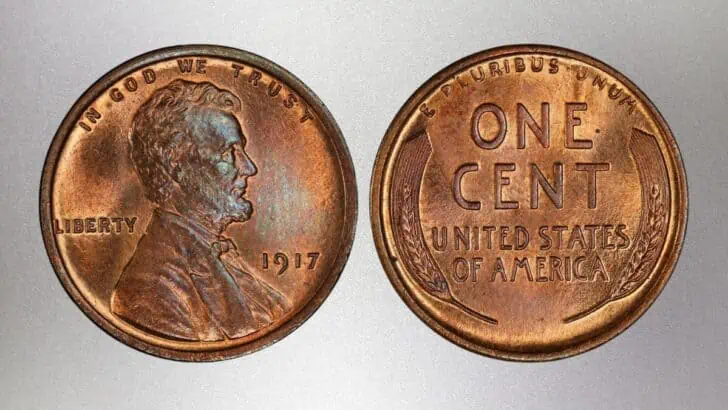The 1917 Lincoln wheat penny is a coin that many collectors yearn to own. Truly outstanding examples are rare, and infrequently come to market. A collector seeking a quality specimen for a collection may have to wait for some time before being satisfied, and bargains will be uncommon.
Production of the 1917 Lincoln Wheat Penny
The three U.S. Mints produced, between them, nearly 300,000,000 Lincoln wheat pennies in 1917. The Philadelphia Mint produced far and away the most coins, and 1917 wheat pennies remain available at reasonable prices in the circulated grades. Pennies struck in Denver and San Francisco are less common, and while coins from those mints are available at the lower grades, like Good and Fine, they become less available and more expensive as we move up the grading scale.
| Date | Philadelphia | Denver | San Francisco |
| 1917 | 196,429,785 | 55,120,000 | 32,620,000 |
How Much Are 1917 Wheat Pennies Worth?
When examining a 1917 penny, from any of the three mints, consider the quality of the striking as well as the grade. Many very nice wheat pennies from that year are well-struck with full details. On the other hand, as many or more have weak strikes, which arose when the die degraded from use during the minting process. Many dealers and the major grading services are more interested in “wear” as an element of grading, than “quality of strike.”
In other words, a given 1917 penny could be graded quite highly, and still not show up very well next to sharper coins of lower grade. For that matter, a sharply struck brown coin may very easily look much nicer than a weakly struck red-brown or red coin of the same grade. The brown coin will also be much less expensive. Collectors should be patient, and not “snap up” a weak strike simply to have a 1917 penny in the collection.
As an example of the importance of quality of strike, compare this coin, a 1917-D wheat penny, graded MS-62-BN, to this coin, a 1917-S wheat penny, graded MS-64 RD. It is certainly true the brown coin shows a few more bag marks, nicks and scratches. The red coin is certainly shiny and has its luster. But the brown coin shows somewhat more sharpness of detail. The ear, the bow tie, and the hair on Lincoln’s portrait all show somewhat more detail. On the red coin these details aren’t worn, they simply didn’t appear to begin with. Investors, thinking only of the grade, the color, and the price, might happily bid the price of the red coin up, to nearly $1,700. A collector, wanting something to show in a cabinet or display case, might easily start with the brown coin for $99.00, and be justly proud of both a discerning eye and a frugal disposition.
| 1917 Penny Value Chart | ||||
| Date | Grade | |||
| Good G4 | Uncirculated MS64 | Uncirculated MS65 | Uncirculated MS66 | |
| 1917 1C BN | $0.36 | $54.00 | $156.00 | — |
| 1917 1C RB | — | $81.00 | $176.00 | $390.00 |
| 1917 1C RD | — | $247.00 | $468.00 | $1,220.00 |
| 1917-D 1C BN | $0.75 | $156.00 | $390.00 | — |
| 1917-D 1C RB | — | $468.00 | $748.00 | $2,380.00 |
| 1917-D 1C RD | — | $585.00 | $1,500.00 | $8,750.00 |
| 1917-S 1C BN | $0.55 | $221.00 | $618.00 | — |
| 1917-S 1C RB | — | $358.00 | $1,020.00 | $3,750.00 |
| 1917-S 1C RD | — | $1,500.00 | $10,600.00 | $40,800.00 |
Values for 1917 Pennies
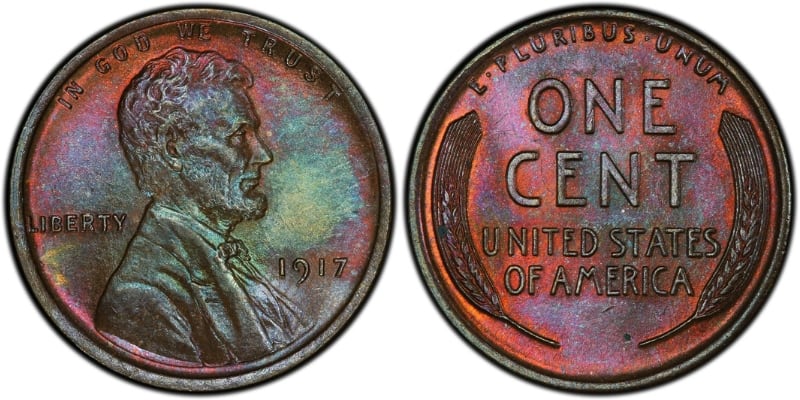
Wheat pennies minted in Philadelphia in 1917 are readily available in all circulated and most uncirculated grades. Mint-state coins are often treated or dipped, however, and may have been cleaned by unwitting collectors or unscrupulous dealers.
A collector might reasonably expect to find 1917 wheat pennies graded “good” or “fine” for less than a dollar. Extremely fine brown pennies should cost around $5, while about-uncirculated 1917 pennies should cost a bit over $15.
Brown uncirculated 1917 pennies should cost between $30 and $45 at grades below MS-63, and less than $200 at grades below MS-65.
Truly spectacular red 1917 wheat pennies, showing their original color and luster, are much harder to come by, and high quality MS-67 red coins command high prices at auction. In August 2022, Heritage Auctions sold a 1917 MS-67 RD penny for $5,040. The coin has not only excellent luster and a nearly flawless surface, it also benefits from a very sharp strike which makes the details of the coin perfectly crisp and clear. A similar coin, graded MS-67+, sold for $8,812.50 in September 2015. Once again, the penny benefited not only from a wonderful tone and flawless surface, but also the clarity of a sharp strike.
The highest graded 1917 pennies sell for high prices at auction. In April 2012, a 1917 penny, graded MS-68 RD, sold for $29,900 at Heritage Auctions. The catalog noted that only two 1917 wheat pennies had been graded at MS-68, and none had been graded higher.
Values for 1917-D Pennies
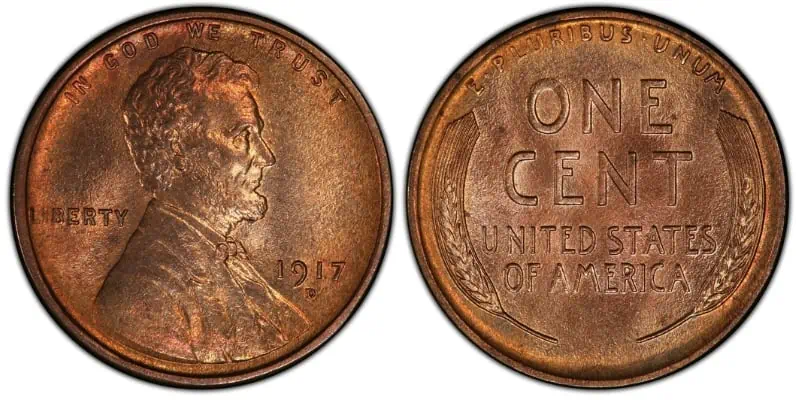
The 1917-D wheat penny is readily available in the grades of Good and Very Good, but becomes more difficult to find at increasingly higher grades. Compounding the problem, such uncirculated coins as may be readily available are often weakly struck. One writer describes the quality for the year as ranging from “below average to wretched.” Well-struck examples with bold details exist, but are rare. In many cases, coins show spots, and early efforts at cleaning or dipping.
Paradoxically, although the Denver Mint struck more pennies in 1917 than the San Francisco Mint, circulated pennies from Denver tend to be consistently higher priced than circulated pennies from San Francisco in the equivalent grade. The situation reverses for uncirculated coins.
Buyers should be able to find low-graded 1917-D wheat pennies, at “Good” or below, for under a dollar. For “Fine” pennies, the price rises to $3.38. “Extremely Fine” and “About-Uncirculated” 1917-D Lincoln pennies should cost between $40 and $60. Clearly, beginning collectors looking to fill a “penny book,” may have to settle for a coin of lower grade than they might otherwise want.
At the uncirculated level, a well-struck mint-state 1917 wheat penny with original red luster is rarely found in the market. In many cases, coins show spots, and early efforts at cleaning or dipping. Brown 1917-D wheat pennies graded between MS-63 and MS-65 should reasonably cost between $150 and $400. Red-brown pennies of the same grade ought to cost between $200 and $750.
In June, 2021, a 1917-D penny, graded MS-65 RD sold for $1,200 at auction. In August, 2022, a 1917-D penny graded MS-65+ RD sold for $5,640 at Heritage Auctions. The catalog took pains to point out that the obverse was well-struck, and the reverse almost as crisp, with only some weak points at the bottom of the wheat stalks.
In all cases, whether considering circulated or uncirculated 1917-D pennies, careful examination of the actual coin is key. As with the 1917 penny, certification services do not always factor in the sharpness of the strike in assigning a grade, and the wise buyer will examine this detail in a 1917-D wheat penny carefully before putting down money.
Values for 1917-S Pennies
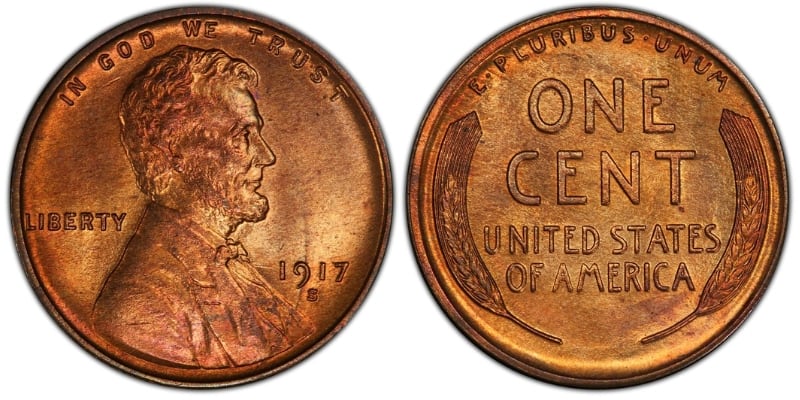
The 1917-S wheat penny is common at the Good to Very Fine grades, and often cheaper than a 1917-D wheat penny of the same grade. The lowest grades of 1917-S penny, “Good” and “Fine”, should cost between $0.55 and $1.50. Higher graded circulated pennies, at “Extremely-Fine” and “About-Uncirculated” grades should be available at prices between $12 and $40. These are not low prices for beginning collectors, and, once again, a good eye and patience might be rewarded.
The 1917-S wheat penny is difficult to find in mint-state condition, and as such, it is considered a key date in the Lincoln penny series by collectors. High grade circulated coins are also somewhat difficult to find, and can be expensive. Well-struck and spot-free uncirculated coins in grades of MS-65 or higher, with red tone, are quite rare.
Even the lower grades of uncirculated coins can be expensive at auction, compared to coins struck in Philadelphia. In September 2023, a 1917-S wheat penny graded MS-63 BN sold for $149 at Heritage Auctions. In November 2023, a 1917-S wheat penny graded MS-63 RB sold for $139. Higher prices, from $160 to $200 are not unheard of. Gem quality red coins, graded above MS-65 can be quite expensive at auction. In May 2023, a 1917-S penny, graded MS-65 RD sold for $18,000 at Heritage Auctions. The catalog, in explaining the sharpmess of the strike, pointed out that during World War I, all three mints ran three shifts to produce coins, which led to excessive wear and tear on the dies. While this was bad enough at Philadelphia, Denver and San Francisco dies had even harder use, as all replacements came from Philadelphia, and so new dies were sent to the other mints less often.
Dies made early in 1917 for use at the San Francisco Mint were impressed with the same mint mark punch used since 1909. Later in the year, a new mint mark punch, with a slightly larger “S,” entered service. Although specialists have commented upon this change, no one has yet seen fit to catalog the two as separate varieties.
Were any 1917 Proof Lincoln Wheat Pennies Produced?
The U.S. Mint discontinued coining proof sets in 1916, saying there was insufficient demand from collectors and the general public. Proof coinage would not be resumed by the Mint until 1936.
Despite the official ending of proof coinage the year before, allegations of an unauthorized or “clandestine” strike of 1917 matte-finished proof wheat pennies have circulated in the numismatic world since the mid-1960’s. Coins said to be 1917 proof pennies entered the market at that time, along with some other unexpected coins such as a 1921 proof Peace dollar.
Expert opinion varies on the legitimacy of these coins. Brees listed them in a reference in the 1980s, while Bowers describes the 1917 wheat penny proof and the 1921 proof Peace dollar as “impostors.”
Bowers went on to state there is no contemporary reference to the proof wheat pennies, either in sales material or in Mint documents from the period. He also points out that legitimate U.S. proof coins of the era had “broad, flat rims,” which had a mirror-finished surface when seen edge-on. The alleged 1917 wheat penny proofs lack both of these features. The two main certification services do not recognize 1917 wheat penny proofs, and it is fair to state there are no legitimate 1917 proof wheat pennies.
Barring further documentary discoveries from the Mint, or elsewhere, buyers should beware, and proceed on the theory that there are no genuine 1917 proof Lincoln wheat pennies.
How Much Are 1917 Wheat Penny Errors and Varieties Worth?
1917 Doubled Die Obverse Wheat Pennies
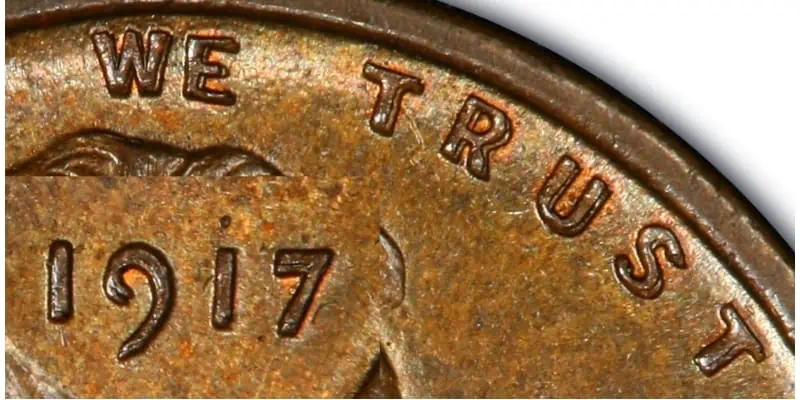
| 1917 Penny DDO Value Chart | |||
| Date | Grade | ||
| Uncirculated MS63 | Uncirculated MS64 | Uncirculated MS65 | |
| 1917 1C DDO BN | $7,500.00 | — | — |
| 1917 1C DDO RB | $8,120.00 | $9,000.00 | $10,900.00 |
| 1917 1C DDO RD | $10,000.00 | $12,600.00 | $18,000.00 |
A doubled die variety arises when the die, the mould used to create coins, is struck improperly during manufacture. In order to create a die, it is hit several times with a master “hub” containing the image of the coin. Ideally, these blows should fall in the same place each time. If one or more is misaligned, two or more images will appear on the die, and on every coin minted using that die. Collectors eagerly seek doubled die varieties, and the known doubled die varieties have been cataloged by several different writers.
In 1917, the Philadelphia Mint created a doubled die variety, which is somewhat subtle, compared to similar doubled die varieties from other years. Bowers describes the appearance as “slight, but obvious.” It can best be on the date and in the motto “In God We Trust.” The very first coins struck using this die may also show doubling on the letters “RTY” in the word “Liberty.” As the die deteriorated from use, this particular aspect faded.
Bill Fivaz, a specialist in the subject of die varieties of U.S. coins, describes the 1917 doubled die obverse as immensely popular with collectors and highly sought after. Even the lowest-grade specimens can readily be sold and higher-grade specimens realize significant sums among dealers or at auctions. Bowers, writing some years ago, said the 1917 doubled die variety isn’t as well-known among general collectors, but better-known among specialists. He argues that because of the lack of general knowledge, it may still be possible to find some specimens not yet identified by careful examination of 1917 wheat pennies.
In December 2023, a 1917 doubled die penny, graded F-15, sold for $192 at auction. A somewhat nicer specimen of circulated 1917 doubled die penny, graded AU-55, sold for $2,280 in November 2023. Uncirculated specimens are rare, and don’t often appear at auction. Most recently, in November 2023, a 1917 doubled die wheat penny graded MS-65 RD sold for $19,200 at auction.
Off-Center Strikes and Broadstrikes of 1917 Lincoln Wheat Pennies
As with other wheat pennies, collectors seek errors. These exist, although they are somewhat overshadowed by the doubled die obverse, which commands interest. In September 2023, a 1917 wheat penny, struck off center and graded AU-55 sold for $169 at auction. Had the same coin been correctly struck, it would have sold for about $15. In 2019, a 1917-D penny, graded MS-64 BN, struck 35% off center sold for $960. The correctly struck coin would have sold for about a third of that price.
Technical Specifications of the 1917 Lincoln Penny
The year 1917 was the ninth in which the wheat penny was issued. The Lincoln wheat penny first appeared in 1909 to commemorate the centennial of the birth of Abraham Lincoln. The design was immensely popular, and has, in one form or another, endured as one of the longest-running coin designs in the world.
The designer of the coin, Victor D. Brenner, was a medallion sculptor and engraver, who created a side-profile of Lincoln for the obverse, and a pair of highly stylized wheat stalks for the reverse, thus giving the coin its name.
The 1917 Lincoln wheat penny is a bronze coin. The alloy, of 95% copper and 5% tin and zinc, yields a weight of 3.11 grams for a coin 19 millimeters in diameter.
Summary
The 1917 wheat penny is a highly sought coin. Collectors have to pay close attention to details outside the simple issue of grading in order to find the best choices, which may not always be the most obvious, or shiniest pennies. Patience and caution are good traits to cultivate when shopping for coins, and will serve a collector well here. Beginning collectors may wish to seek help from more experienced friends, or to start with lower graded circulated coins to build their collections.
